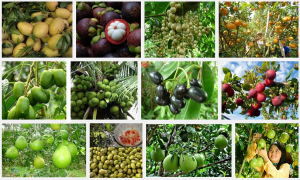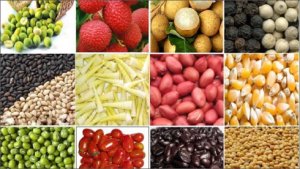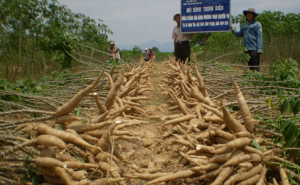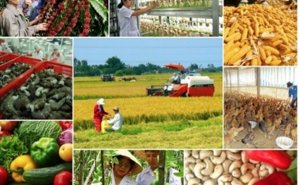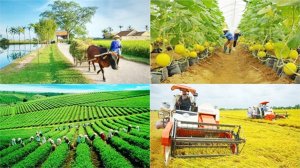|
2014 Agricultural Restructuring and New Devolepment
Monday, 2015/01/05 | 15:47:40
|
|
Bui Chi Buu January 2015
2014 was the International Year of Family Farming, and throughout the year, IAS worked with our partners to keep the spotlight pinned on this critical player in the country food, nutrition and agriculture arena. Typhoon struck between two planting seasons - damaging crops that were ready to harvest, harvested and newly planted. The 10th anniversary of the 2004 Indian Ocean Tsunami, which claimed the lives of over 200,000 people, reminded us that climate change and agriculture are interrelated processes in our development strategy. Global warming is projected to have significant impacts on conditions affecting agriculture, including temperature, carbon dioxide, glacial run-off, precipitation and the interaction of these elements. The IAS is seeing that production systems with more diverse varieties and crop are resilient to the climate change. Crop products are met the demand of various markets, customer preferences then farmer profits would be increased as agricultural restructuring goal.
In 2014, the total export turnover of agro-forestry and fisheries exceeded the sector's annual target, hitting a record of US$ 30.86 billion, up nearly 11.2% as compared to 2013 (the surplus of $ 3.06 billion). The agricultural GDB value increased 3.3% (based on 2010 standard) including the increment of agriculture, sylviculture and fishery of 2.63%, 6.60% and 6.50%, respectively. New figures were recorded as forest cover percentage of 41.5%, and 718 communes met the demand of new rural development standards.
Rice growing areas developed 7.86 million ha (54,000 ha decreased) with rice production of 45.0 million T (2.3% increased) and average yield of 5.77 t/ha (0.17 t/ha increased). The milled rice export of 6.50 MT obtained the turnover value of $ 3.0 billion (5.3% increased) in 2014.
Fruit orchards developed 843,700 ha (7,900 ha increased) with production of 930,000 T. The export turnover of fruit and vegetable offered a new record of $ 1.47 billion (34.9% increased).
Maize growing area is 1.21 M ha (38,000 ha increased) with average yield of 4.50 t/ha. Total maize production gained 5.45 million T (4.8% increased).
Cassava growing area is 560,000 ha (4,000 ha decreased) and obtained 10.36 million T with cassava productivity of 18.5 t/ha (0.60 ton increased). The export turnover of cassava products offered a new record of over $US 1 billion.
Sweet potato growing area is 141,000 ha and obtained 1.46 million T (7.1% increased), in particular Vinh Long province production and areas.
Vegetable areas increased up to 1 million ha (2.7% increased) with the production of 14.8 million T.
Sugarcane developed 309,700 ha with the production of 20 MT (969,000 ton increased) and average yield of 64.5 t/ha (1.5 ton/ha increased).
Soybean growing area is 114,500 ha with the production of 162,000 ton
Groundnut growing area is 217,500 ha with the production of 494,500 ton (47,000 ton increased) and the average yield of 2.30 t/ha.
Rubber area is 970,000 ha (over 170,000 ha as compared to plan) including 530,000 ha for production of 954,000 ton of latex. The average yield offered 1.72 t/ha. The export turnover of rubber offered $US 1.8 billion (28.9% decreased).
Cashew nut cultivated area is slightly reduced 305,000 ha with the productivity of 0.91 t/ha and the production of 279,000 ton (10,000 ton decreased). Raw materials imported from Africa and Cambodia occupied 50% of the demand. The export turnover of cashew nut products offered a new record of over $US 2 billion (21.1% increased).
Black pepper is welcome to its promotion of 52,000 ha including 47,000 ha for production with good price in the market. Pepper production obtained 125,000 (2.5% increased) and the average yield gained 2.65 t/ha. The export turnover of black pepper offered a new record of $US 1.2 billion
Coffee growing areas is 590,000 ha with the average yield of 2.15 t/ha and the production of 1.36 million T. The export turnover of coffee offered a new record of $US 3.6 billion
Tea growing area is 135,000 ha (5.4% increased) with the production of 984,000 ton (6.7% increased) and the average yield of 7.96 t/ha. The newly replanted areas accounted for 53% to be ready in harvesting mechanization.
Coconut cultivated area is 145,000 ha including 128,000 ha for production with the average yield of 9.45 t/ha and the production of 1.21 MT.
Smallholder husbandry farming policy was received the support by GOV in 2014 for sustainable and safety development according to Decision 50/2014/QD-TTg in September 4, 2014 beside modern husbandry farms establishing. The livestock population of the country in the year varied a little bit due to market price fluctuation and epidemic diseases.
Total meat production obtained 4.47 million T (2.7% increased); egg and milk increased 3.8% and 15.6%, respectively. Animal feedstuff production was estimated to get up to 14.7 million T (10% increased as compared to 2013).
Product value in husbandry obtained VND 151,392 billion (2.3% increased) based on 2010 standard. Husbandry accounted for 24.5% of total agricultural value in the country.
In 2014, aqua production obtained 6.3 million T (5% increased), particularly cultivated one gained 3.62 million T (4% increased) with shrimp production of 660,000 T (20.4% increased). Aquaproduct value in 2014 was estimated getting 6.43% increased as compared to 2013. The export turnover of shrimp and Pangasius fish offered $US 4.0 billion and $US 1.8 billion (28% and 0.6% increased), respectively.
The export turnover of wood and wood products offered a new record of $US 6.54 billion. Product value in Forestry increased 6.6% with 212,000 ha of new reforested areas (6.8% decreased).
The 2014 picture demonstrated the initial effectiveness by agricultural restructuring. There was a positive conversion from quantitive development into further quality how to give more profit to our farmers. Vietnam initiated economic renovation in 1986, shifting from the centrally-planned economy with state subsidies to a socialist-oriented market economy in implementation of industrialization, modernization of the country. Agriculture is an important part in Vietnam economic structure. It makes a considerable contribution to export turnover, GDP and creates the largest amount of jobs, and is the main source of the poor’s income.
IAS scientists will commemorate the 90th anniversary in 2015 to declare the position and responsibilities of one of the oldest institutions in Vietnam undertaking agriculture promotion in terms of Southern Vietnam. IAS has pointed out the main targets to achieve in agriculture. Firstly, national food security must be ensured in particular Southern regions. Secondly, agriculture has to supply enough raw materials for industry. Thirdly, export turnover increases to 8 – 9 billion USD per year. Besides, technical and scientific achievement should be widely applied in agricultural production in order to obtain the goals of high productivity, high quality met good price for our farmers’ better income.
Any your kind cooperation would be appreciated. |
|
|
|
[ Other News ]___________________________________________________
|


 Curently online :
Curently online :
 Total visitors :
Total visitors :


